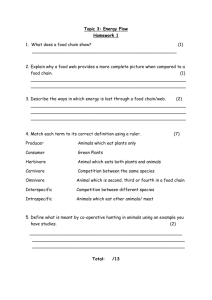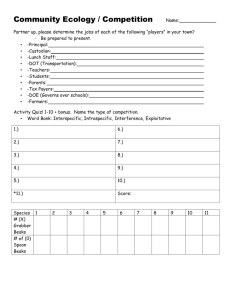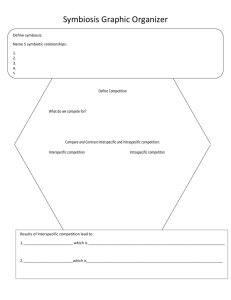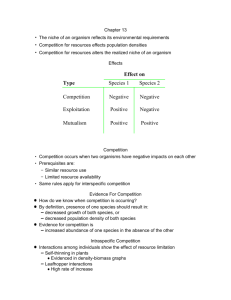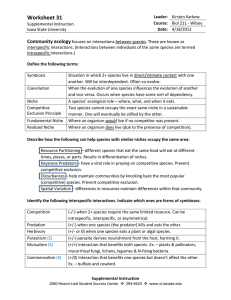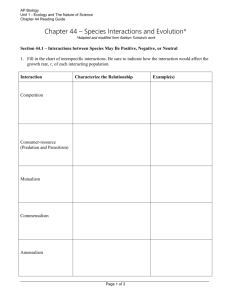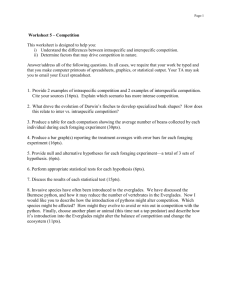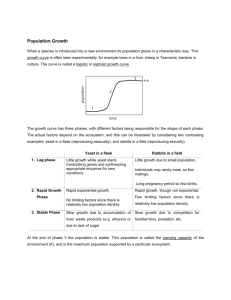Types/Terms describing Interspecific Interactions 12/2/2011
advertisement
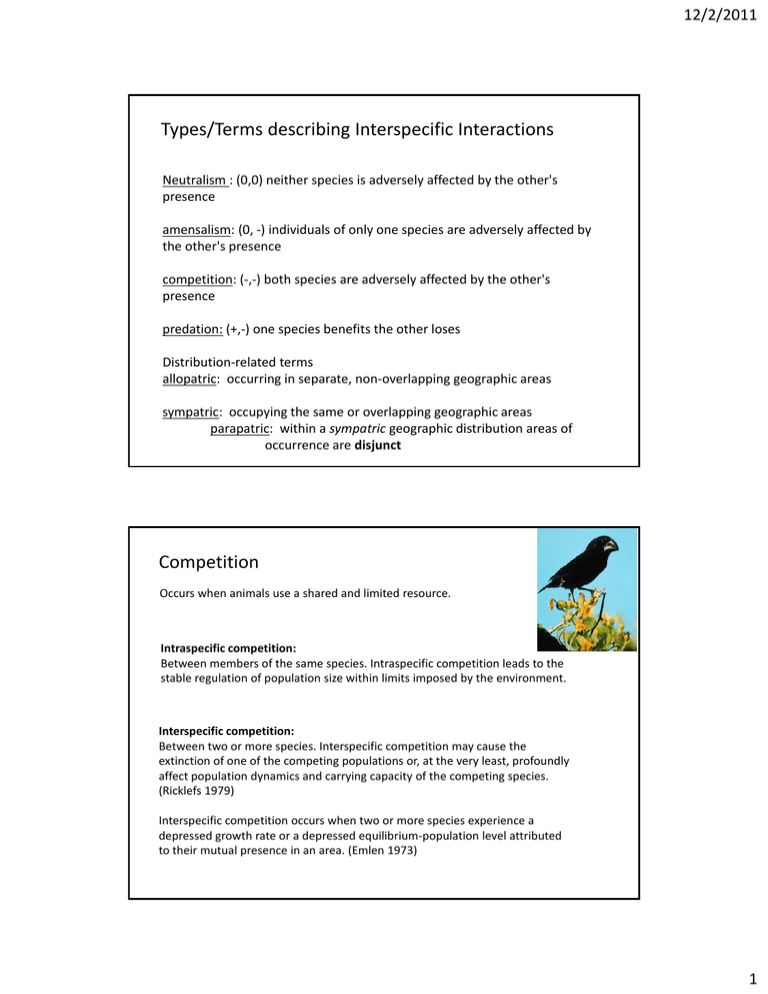
12/2/2011 Types/Terms describing Interspecific Interactions Neutralism : (0,0) neither species is adversely affected by the other's presence amensalism: (0, -) individuals of only one species are adversely affected by the other's presence competition: (-,-) both species are adversely affected by the other's presence predation: (+,-) one species benefits the other loses Distribution-related terms allopatric: occurring in separate, non-overlapping geographic areas sympatric: occupying the same or overlapping geographic areas parapatric: within a sympatric geographic distribution areas of occurrence are disjunct Competition Occurs when animals use a shared and limited resource. Intraspecific competition: Between members of the same species. Intraspecific competition leads to the stable regulation of population size within limits imposed by the environment. Interspecific competition: Between two or more species. Interspecific competition may cause the extinction of one of the competing populations or, at the very least, profoundly affect population dynamics and carrying capacity of the competing species. (Ricklefs 1979) Interspecific competition occurs when two or more species experience a depressed growth rate or a depressed equilibrium-population level attributed to their mutual presence in an area. (Emlen 1973) 1 12/2/2011 Intraspecific Competition How did we model intraspecific competition? (density dependent growth – logistic growth curve) ln(n t+1) = ln (nt) + rmax + b(nt) + F Another form of this equation is: dN/dt = r N (1 – N/K) where r is the max growth rate K is the carrying capacity Do you recall how we add another species into the mix? Theoretical Models of Interspecific Competition We add term to the model that converts one species into units of another The Lotka-Volterra model incorporates interspecific competition by using a parameter called alpha. Alpha is the coefficient of competition (or competition coefficient) and measures the competitive effect of one species on another. For example: a12 is the effect of species 1 on species 2. a21 is the effect of species 2 on species 1. Note: the notation for competition coefficients is not consistent among textbooks or computer programs (output). For example, Begon and Mortimer (1986) define a12 as the effect of species 2 on species 1, which is opposite of the definition stated above. Some computer programs may use Greek symbols such alpha and beta to represent a12 and a21, respectively. The bottom line is to make sure you understand the notation used by a particular author or computer model. 2 12/2/2011 Regardless of the notation used, the coefficient of competition measures interspecific competition relative to intraspecific competition. e.g., how many individuals of species 2 are equivalent to one individual of species 1 in terms of their use of the resource. For example: If one elk (species 1) is equivalent to 3 deer (species 2) in terms of its use of the resource and its effect on species 2, then a12 = 3.0. If the effect of species 2 on species 1 is reciprocal (i.e., if 1 deer is equivalent to 0.33 elk), then a21 = 0.33. Note: the alpha's of each species do not have to be reciprocal. Theoretical Models of Interspecific Competition We add the number of species 2 converted into ‘units’ of species 1 to the logistic equation to account for interspecific competition: And do the same for species 2 growth, converting species 1 into ‘units’ of species 2: 3 12/2/2011 The zero-growth isocline describes expected equilibrium population sizes of one species if abundance of the second species is held constant, and vice versa. The relationship between the two species is assumed to be linear, i.e., the isoclines for species 1 and species 2 can be written as equations for a straight line (y = a + bx). We do the same thing for species 2, converting species 1 into units of species 2 Then we can put the isoclines of both species on the same plot to see the potential outcomes of competition. These are the Lotka-Volterra equations for competition. 4 12/2/2011 5 12/2/2011 Interspecific competition using mechanisms by which it occurs (Tillman’s Model) Examine competition and it’s possible outcomes based on resource use, not numbers like the L-V approach 6 12/2/2011 How Important Is Competition in Regulation of Animal Numbers? Two camps: 1) Competition (both intra- and inter-specific) is the dominant ecological interaction Diamond (1978) (Density dependent camp) 2) Variable environments are primary determinants of population dynamics not competition (Andrewartha and Birch 1954, Weins 1977) (Density Independent Camp) Resources are rarely limiting, and if so rarely stay so long enough for full effects of competition to emerge Thoughts? 7 12/2/2011 How do we evaluate the potential for competition? • Compare resource use-distributions in presence and absence of the other species. • Evaluate the similarity of the species. • Best would be to compare growth rates and equilibria in presence and absence of other species. Remember Gause? Competitive Exclusion PrincipleNo two species can fill the same niche (compete for the same resource) for very long. Eventually leads to displacement / partitioning of the shared resource in space or time, or lack of coexistence. Resource partitioning in MacArthur’s Warblers 8 12/2/2011 Niche shifts: fundamental vs realized niche and character displacement How do we know if we are seeing ‘current’ competition versus ‘ghosts of competition past’? Character Displacement – Darwin’s Finches 9 12/2/2011 Does interspecific competition play a role in the structure of desert rodent communities? Munger and Brown 1981 Eight 50m x 50m exclosures: 4 with openings big enough for large granivores (Dipodomys spp), small granivores, and small omnivores to pass 4 with openings only small granivores and omnivores could pass Trapped and removed all Dipodomys from small opening exclosures and then trapped monthly to document change in numbers. If there is interspecific competition and large species influence smaller ones, what would we predict about small rodent densities after large rodent exclusion? Would we expect the reponse to be the same for small granivore and small omnivore groups? If so what would this suggest, if not what? 10 12/2/2011 What do these results suggest? Trapped and removed all Dipodomys from small opening exclosures and then trapped monthly to document change in numbers. If there is interspecific competition and large species influence smaller ones, what would we predict about small rodent densities after large rodent exclusion? Appears to be, small granivore densities increased 350% in absence of large granivore species Would we expect the reponse to be the same for small granivore and small omnivore groups? If so what would this suggest, if not what? Omnivores did not respond as strongly as granivores suggesting competition for food resources as driving factor 11
